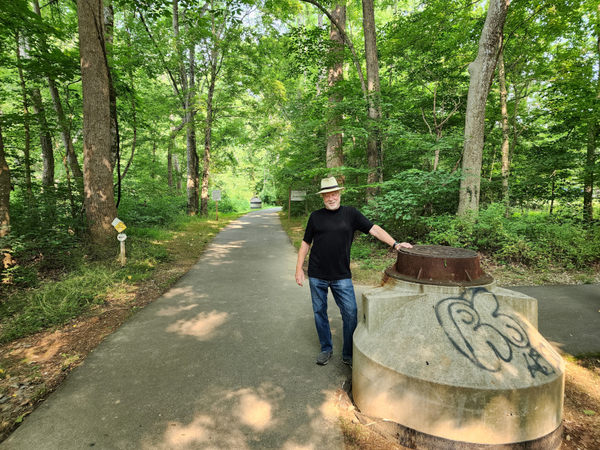Grow with the Flow
What are interceptors, and why are so many in the budget?

As Hillsborough residents read through the town’s budget for Fiscal Year 2024, they might notice a word that pops up several times in the Capital Improvement Plan section: interceptor.
The budget includes financial planning over multiple years for large projects, including four projects that involve sewer interceptors by Bellevue Mill, Exchange Club, and the Eno River. The interceptors are not cheap. But what exactly are they, and how would upgrading and repairing them affect Hillsborough’s growth prospects?
Sewer interceptors, or sewer outfalls, are conduits that run through a series of manholes from residential and commercial sewer line connections to the Wastewater Treatment Plant where wastewater is treated and clean water is discharged into the river.
“If you live on a residential street or a cul-de-sac, an interceptor is the highway,” said Bryant Green, environmental engineering supervisor for the town’s utilities department. “Your house’s sewer line wouldn’t directly connect to an interceptor, just like your driveway wouldn’t connect directly to I-40.”
Hillsborough has two main interceptors. One runs along the Eno River, and the other along Cates Creek. The town has grown and developed considerably and more quickly than anticipated since the interceptors were installed. In addition to residential density, rain events create a surge in groundwater and a rise in stream levels, further testing the capacity of the interceptors. The result is that the system becomes backed up or congested. Once the current system has reached maximum capacity, future growth could come to a standstill.
Most of the interceptor-related projects will increase the size of the main pipes that carry the waste — like widening a road. Temporary sewer lines also will have to be installed to avoid interruption while the main lines are upgraded.
Interceptor projects
Below are brief descriptions of the interceptor projects included in the town’s capital improvements plan. Only one is expected to be funded in part in this fiscal year. More information about these and other projects can be found in the budget. The town will be applying for grant funding. The projects otherwise are expected to be paid for by operating funds or a combination of operating funds and a special low-interest water and sewer infrastructure loan program through the state known as the Revolving Loan Program. Revenue for the Hillsborough Water and Sewer Fund comes primarily from water and sewer charges.
Bellevue Mill interceptor upgrade — To replace 2,700 linear feet of 8-inch sewer pipes with 12-inch sewer pipes and 15 manholes. The Bellevue Mill interceptor extends from near the end of Forrest Street southward to Eno Street. It existed as early as the 1920s, per mill maps. Hydraulic modeling has shown this interceptor is undersized for 2040 growth scenarios. If high-density redevelopment and development in the western part of Hillsborough is desired, this main will need to be upgraded. The estimated total cost for the Bellevue Mill interceptor upgrade is $1.5 million, with $180,000 of the total to be spent on survey and design work and land acquisition. The remaining $1.32 million would go toward construction administration and construction. The work is expected to start in Fiscal Year 2028 and continue through FY30.
Exchange Club interceptors — To replace 2,250 linear feet of 10-inch diameter sewer pipes with 15- or 18-inch pipe. This section of sewers goes through Exchange Club Park, between Orange Grove Road and the Riverwalk greenway. Recent hydraulic modeling of the collection system revealed this interceptor, installed in the early 1970s, has capacity deficiency for existing and proposed growth conditions. Upsizing it with possible realignments will address current and future growth and improve its condition. The estimated total cost for the Exchange Club interceptors is $1.48 million, with $230,000 of the total to be spent on surveys, engineering, easements, permitting and bidding. The remaining $1.25 million would go toward construction administration and construction. The work is expected to start this fiscal year and continue through FY26.
Eno River West interceptor — To replace about 2,900 linear feet of 18-inch sewer pipes with 24-inch pipes along with 12 manholes. The general vicinity of the project is west of Churton Street to Occoneechee Street on the south side of the Eno River. This interceptor was built in the 1970s and is one of the oldest in town. The modeling report shows the sewer main experiences capacity issues during wet weather due to infiltration of the pipe from cracks or breaks. It also is undersized for potential 2040 growth. Estimated total cost for the Eno River West interceptor upgrade is $2.14 million, with $350,000 of the total to be spent on survey, design and bid fees and on land acquisition. The remaining $1.79 million would go toward construction administration and construction. The work is expected to start in Fiscal Year 2027 and continue through FY28.
Eno River interceptors — To replace 18- and 21-inch sewer pipes with at least 30- and 36-inch pipes. The interceptors were constructed with the wastewater plant in the mid-1970s. They are outdated and insufficient to meet committed and projected growth. Under certain conditions, wastewater reaches within 2 feet of the manhole tops. The project area extends from the River Pumping Station along the Eno River to Churton Street. Estimated total cost for the Eno River interceptors is $5.8 million, with the total for construction administration and construction. The work is expected to occur in Fiscal Year 2025.




